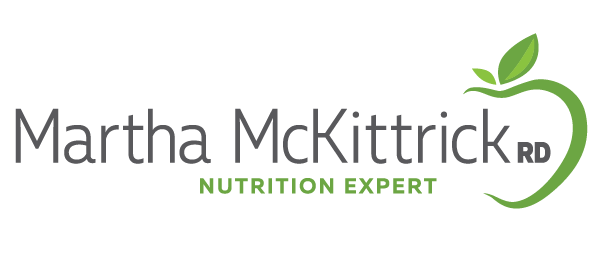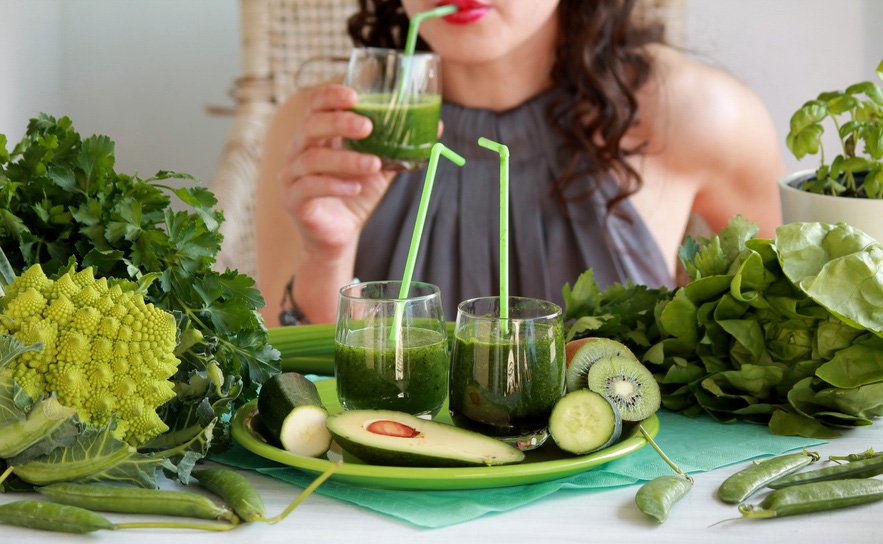How to Make a Healthy Salad Dressing
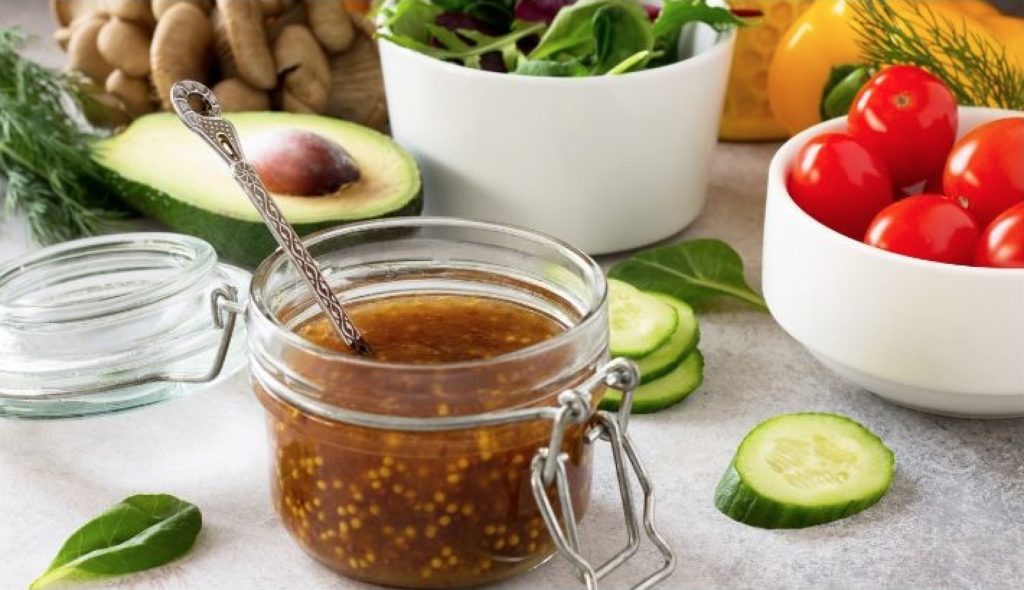
Say goodbye to winter comfort meals and hello to lighter spring and summer foods. Who doesn’t love a salad made from fresh veggies in season? But the wrong kind of salad dressing can pretty much undo the benefits of eating salad! Commercial dressings often contain refined vegetable oils and are loaded with calories, sodium, added sugars, and artificial flavors. Your best bet is to make your own. And it can be a lot more creative than just oil and vinegar. There are so many different ways to dress up your salad and have it bursting with flavor by including some spices, seasonings, herbs, and other flavorful condiments. Read guest blog post by Catherine Scott Fischer for her tips on how make a healthy salad dressing.
How to make a healthy salad dressing:
Oils
Generally most people use 3/4 oil and 1/4 base, but you can change this based on your own taste preference – or if you simply want to cut calories!
- Olive oil: This is probably the oil we are most familiar with! Opt for extra virgin olive oil as it is the purest form, regular bottled olive oil usually consists of a combination between cold-pressed and processed oils.
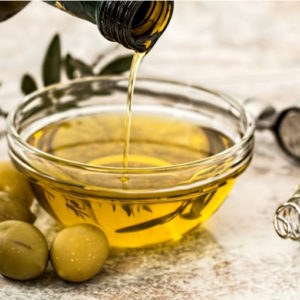 Avocado oil: The buttery taste makes it a more delicate oil yet it contains a subtle nutty flavor which enhances the overall smooth texture.
Avocado oil: The buttery taste makes it a more delicate oil yet it contains a subtle nutty flavor which enhances the overall smooth texture.- Sesame oil: As you might have guessed, it is made from sesame sends and lends a roasted-like flavor. Looking at its nutritional profile, it contains antioxidant properties as it is a great source of vitamin E & K.
- Flaxseed oil: The news is spreading fast on the health benefits attached to ground flaxseed but what about flaxseed oil? It’s simply made from flax seeds but pressed to obtain the oil. Similarly to flaxseeds, flaxseed oil is packed with heart-healthy omega 3 fatty acids! Perfect for salad dressings as its smoke point is too low to cook with.
- Almond oil: Depending on which type of almond is used to extract the oil, sweet or bitter, it will produce a different flavor. The sweet almond is one of the most flavorful oils and evidently has a sweet taste, whereas the bitter almond will produce a pungent flavor. Bitter almond oil is commonly used in baked goods and emits a strong almond flavor.
- Grapeseed oil: Often used interchangeably with olive oil as it is fairly flavorless and odorless therefore does not impart any change in taste in dishes.
Acids
Acids tend to be very tart so you only need a small amount!
- Lemon/lime
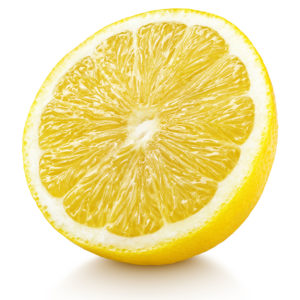 Flavored vinegars:
Flavored vinegars:
– Find a store-bought flavored vinegar such as balsamic with pear and fig pulp. Read my previous blog post on flavored vinegars.
– Make your own with fresh herbs and/or fruits such as strawberries, raspberries, peaches, pears, etc.
– Use apple cider vinegar if you are opting for a fruit-based vinegar.
– Distilled white vinegar if you prefer an herb based vinegar mixture.
– Wine and champagne vinegars both lend a softer flavor and pair well with delicate herbs and more subdued flavored fruits.
– Red wine vinegar couples well with spices and stronger tasting herbs such as rosemary.
If you’re interested in making your own, check out some tips in this blog post!- Orange
Flavor add ins
Although these flavor boosters are optional, they are highly recommended as they really bump the flavor to the next level. They are also all very low-calorie and nutrient dense!
 Mustard – try flavored mustard such as Dijon, champagne, etc.
Mustard – try flavored mustard such as Dijon, champagne, etc.- Salt & pepper: These two, especially salt, really enhance the flavor of any dish. Always put less salt than what the recipe states to taste first, then adjust as needed.
- Sweetener of choice (maple syrup, honey, etc.):A little goes a long way! It can help balance out some strong-tasting additions such as lemon all the while contributing to a perfect balance between sweet and salty in your salad dressing.
- Soy sauce or coconut aminos: Coconut aminos is a great option for those who are trying to reduce their sodium intake. It does not compromise the taste at all, it still has that umami flavor and practically tastes the same as regular soy
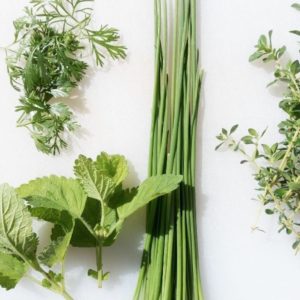 sauce!
sauce! - Miso
- Ginger
- Garlic
- Oregano
- Mint, dill, thyme
- Capers
- Curry powder
- Nutritional yeast
Or to make a creamier dressing: Sometimes we’re not in the mood for a vinaigrette and want a creamier salad dressing. It will usually consist of similar ingredients to a vinaigrette, an oil, acid and flavor add ins with the addition of either yogurt, avocado, or cashews (people often use this to imitate caesar salad).
Healthy salad dressing recipes
Here are a few recipes that are easy to make and are nothing short of incredibly flavorful!
 Sesame Ginger dressing:Sesame Ginger dressings have to be one of my favorite. It tackles on a sweet yet savory profile at once and bursts with flavor. You can also use leftovers as a marinade for tofu, salmon, and chicken, or drizzle it over any veggie bowl! You don’t even need a blender for this recipe, just a bowl and a whisk, does it get much easier?
Sesame Ginger dressing:Sesame Ginger dressings have to be one of my favorite. It tackles on a sweet yet savory profile at once and bursts with flavor. You can also use leftovers as a marinade for tofu, salmon, and chicken, or drizzle it over any veggie bowl! You don’t even need a blender for this recipe, just a bowl and a whisk, does it get much easier?
Nutrition Facts (1/6 of recipe): 98 calories, 9.3g fat, 4.2g carbs
(Picture credit: ambitiouskitchen.com)- Best Balsamic Vinaigrette dressing: Had to include a classic balsamic vinaigrette and this recipe only requires a few ingredients to make, the end result is a slightly creamy and highly satisfying concoction.
Nutrition Facts (1/8 of recipe): 173 calories, 18.9g fat, 2g carbs 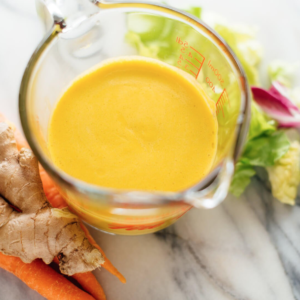 Carrot Ginger Dressing: An Asian style dressing that’s so good and fresh, you’ll want to pour it over everything!
Carrot Ginger Dressing: An Asian style dressing that’s so good and fresh, you’ll want to pour it over everything!
Nutrition Facts (2 tbsp.): 76 calories, 7.4g fat, 3.3g carbs
(Picture credit: cookieandkate.com)- Italian Dressing From Scratch: The use of herbs in this recipe all complement each other and deliver a very fresh and tasteful salad dressing while packing a nutritional boost.
Nutrition Facts (1/6 of recipe): 127 calories, 14g fat, 0.5g carbs - Healthy Honey-Mustard Dressing: Another recipe using greek yogurt as a substitute for mayonnaise to achieve a really creamy, luscious texture. This clever healthy twist really cuts down on the fat and added sugar content you’d tend to find in bottled honey-mustard dressings.
Nutrition Facts (1/6 of recipe): 127 calories, 9.1g fat, 10.3g carbs 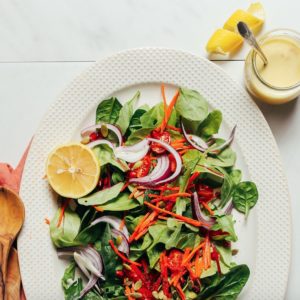 Simple Green Salad with Lemon Vinaigrette: You’d think the 1:1 ratio for amount of oil to acid would make it too sour, but the touch of maple syrup is the crucial component in achieving the perfect balance between the two. Very light salad dressing for those warm summer evenings!
Simple Green Salad with Lemon Vinaigrette: You’d think the 1:1 ratio for amount of oil to acid would make it too sour, but the touch of maple syrup is the crucial component in achieving the perfect balance between the two. Very light salad dressing for those warm summer evenings!
Nutrition Facts (1/4 of recipe): 121 calories, 12.7g fat, 2.6g carbs
(Picture credit: minimalistbaker.com)- Mayo-free Green Goddess dressing: Minimal, simple ingredients, just the way we like it! The greek yogurt is key here to get the velvety, smooth texture pictured below.
Nutrition Facts (1/4 of recipe): 79 calories, 7.2g fat, 2g carbs
Read the label
If you don’t have time to make your own and are opting for a store-bought salad dressing there are a few things you can lookout for to make sure you’re straying away from the extremely caloric and processed options. The first thing you should always do is read the ingredient list, make sure you are comfortable with all of the ingredients. As you probably know, when you look at the ingredient label on any packaged food, the 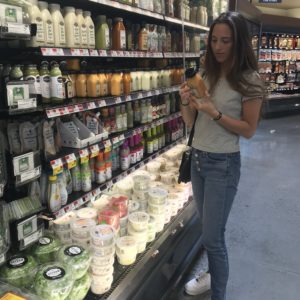 ingredient list is listed in order of predominance. Depending on your health goals, you may want to look out for:
ingredient list is listed in order of predominance. Depending on your health goals, you may want to look out for:
– Added sugars (especially high fructose corn syrup)
– Sodium. Many dressings are high in sodium. This may be an issue if you are watching your sodium intake
– Calories. The calories in many dressing can add up quickly. So make sure you check the calories and portion sizes if you are watching your weight.
– The type of oil used. Some dressings use less healthful refined oils like soybean or other vegetable oils.
– Saturated fat content. Some of the richer or creamier dressings can pack in a lot of saturated fat. This may be important for some people.
– Other additives and preservatives
Below are a few store-bought brands that are much cleaner than the typical bottled salad dressings.
Store-bought options:
Primal Kitchen:Free of any dairy, gluten, refined sugar or soy, and grain. They focus on real, simple, and nutritious ingredients like oil of oregano, apple cider vinegar, and avocado oil. They turn all of your favorite salad dressings, yes even our beloved caesar dressing, into a much healthier alternative and are all incredibly delicious! It’s also a great option for those following a Paleo diet as their products are paleo friendly.
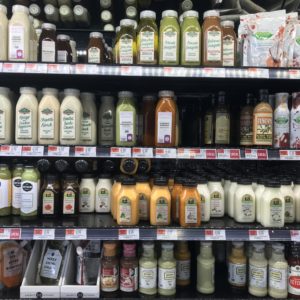 Tessemae’s: All organic! They ditch the refined sugars and use homemade date puree as a sweetener. The products they offer range from organic creamy ranch, classic italian, lemon garlic, green goddess, everything bagel ranch, to barbecue and buffalo sauce! They use a lot of great spices to enhance the flavors and have Keto and Whole30 options as well.
Tessemae’s: All organic! They ditch the refined sugars and use homemade date puree as a sweetener. The products they offer range from organic creamy ranch, classic italian, lemon garlic, green goddess, everything bagel ranch, to barbecue and buffalo sauce! They use a lot of great spices to enhance the flavors and have Keto and Whole30 options as well.
Bragg’s: One of the lower calorie options on the market with very minimal, clean ingredients (as little as 6 ingredients in some!). They currently have five different organic salad dressings all of which contain their organic apple cider vinegar as a base, sometimes combined with extra virgin olive oil, mixed with some different spices such as garlic and ginger. I love their ginger and sesame dressing!
Bottom Line
The options for salad dressings are endless and you can get really creative when it comes to healthfying your favorite store-bought salad dressings that are most likely filled with sodium, added sugar, and processed ingredients. Luckily nowadays, there are many healthier alternative salad dressings so if you are opting for store-bought, always remember to read the label!

I’d like to thank Catherine Scott Fischer for writing this blog post. Catherine is a senior at New York University studying Nutrition and Dietetics. She was born and raised in Belgium and moved to the US when I was 18. This move coincided with a drastic change in her diet and she developed a passion for healthy, plant-based food! She has been vegetarian for 6 years and transitioned into a vegan lifestyle a year and a half ago. Catherine loves running, dancing and cooking! Stay tuned for more of her blog posts.
I’d love to hear what your favorite salad dressing is!
References:
https://extension.colostate.edu/topic-areas/nutrition-food-safety-health/flavored-vinegars-and-oils-9-340/)
https://www.today.com/food/best-healthy-oils-cooking-salad-dressings-more-t126532
https://www.healthline.com/nutrition/almond-oil#section3
http://pennstatehershey.adam.com/content.aspx?productId=107&pid=33&gid=000317
https://www.tastingtable.com/cook/national/extra-virgin-olive-oil-vs-olive-oil
RELATED POSTS
MEET MARTHA
I especially love problem-solving, whether it’s helping women defeat issues plaguing them for years, helping a busy executive find practical ways to get heart healthy, or providing tips to help you reverse diabetes. That’s why I’m on a constant quest to expand my knowledge by staying on top of the latest research.
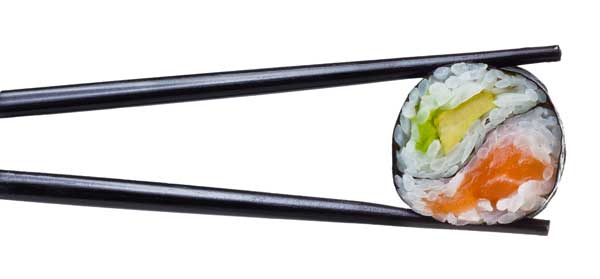
20 Ways To Eat Out 550 Calories or Less!
No time to cook? We’ve got you covered. Here are 20 healthy meals from a variety of cuisines that won’t pack on the pounds. Most of them also have less than 30 grams of carbs.
Subscribe to my newsletter and get this free download.
